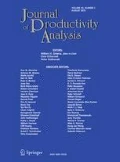Abstract
This paper develops measures, based on the Malmquist index, that enable the decision making units’ internal inefficiencies to be distinguished from those associated with their group (or program) characteristics. The applicability of these measures is illustrated with the assessment of bank branches’ performance. The analysis involves the construction of an index reflecting the relative performance of branches in four different regions, which can be decomposed into an index for the comparison of within-group efficiency spread, evaluating internal managerial efficiencies, and an index for the comparison of frontier productivity, reflecting the impact of environmental factors and regional managerial policies on branches’ productivity.



Similar content being viewed by others
References
Banker RD (1996) Hypothesis tests using data envelopment analysis. J Prod Anal 7(2–3):139–159
Banker RD et al (1989) An introduction to data envelopment analysis with some of its models and their uses. Res Governmental and Nonprof. Account. 5:125–163
Berg SA et al (1993) Banking efficiency in the nordic countries. J Banking Financ 17:371–388
Berg SA, Forsund FR, Jansen ES (1992) Malmquist indices of productivity growth during the deregulation of norwegian banking, 1980–989. Scand J Econ 94: S211–S228
Brockett PL et al (1998) DEA evaluations of the efficiency of organizational forms and distribution systems in the us property and liability insurance industry. Int J Syst Sci 29(11):1235–1247
Brockett PL, Golany B (1996) Using rank statistics for determining programmatic efficiency differences in data envelopment analysis. Manag Sci 42(3):466–472
Camanho AS, Dyson RG (1999) Efficiency, Size, Benchmarks and targets for bank branches: an application of data envelopment analysis. J Oper Res Soc 50:903–915
Caves DW, Christensen LR, Diewert WE (1982) The economic theory of index numbers and the measurement of input, output, and productivity. Econometrica 50(6):1393–1414
Charnes A, Cooper WW, Rhodes E (1981) Evaluating program and managerial efficiency: an application of data envelopment analysis to program follow through. Manag Sci 27(6):668–697
Charnes A, Cooper WW, Rhodes E (1978) Measuring the efficiency of decision making units. Eur J Oper Res 2:429–444
Cook WD et al (1998) Hierarchies and groups in DEA. J Prod Anal 10:177–198
Cummins JD, Weiss MA, Zi H (1999) Organizational form and efficiency: the coexistence of stock and mutual property-liability insurers. Manage Sci 45(9):1254–1269
Dyson RG et al (2001) Pitfalls and protocols in DEA. Eur J Oper Res 132(2):245–259
Elyasiani E, Mehdian S (1995) The comparative efficiency performance of small and large us commercial banks in the pre- and post-deregulation eras. Appl Econ 27: 1069–1079
Elyasiani E, Mehdian S (1992) Productive efficiency performance of minority and nonminority-owned banks: a nonparametric approach. J Banking Finan 16(5):993–948
Fare R, Grosskopf S (1996) Intertemporal production frontiers: with dynamic DEA. Kluwer Academic Publishers, Dordreicht
Fare R et al (1994) Productivity developments in swedish hospitals: a malmquist output index approach. In: Charnes A, Cooper WW, Lewin AY, Seiford LM (eds) Data envelopment analysis: theory, methodology and applications. Kluwer Academic Publishers, Boston, pp 253–272
Fare R, Grosskopf S, Russell RR (eds) (1998) Index numbers: essays in honour of sten Malmquisit. Kluwer Academic Publishers, Dordreicht
Fare R, Lovell CAK (1978) Measuring the technical efficiency of production. J Econ Theory 19:150–162
Farrell MJ (1957) The Measurement of productive efficiency. J Roy Stat Soc Ser A:252–267
Forsund FR (1993) Productivity growth in norwegian ferries. In: Fried HO, Lovell CAK, Schmidt SS (eds) The measurement of productive efficiency. Techniques and applications. Oxford University Press, Oxford, pp 352–373
Frisch R (1936) Annual survey of general economic theory: the problem of index numbers. Econometrica 4:1–38
Golany B, Storbeck J (1999) A data envelopment analysis of the operational efficiency of bank branches. Interfaces 29(3):14–26
Grifell-Tatjé E, Lovell CAK (1997) The sources of productivity change in spanish banking. Eur J Oper Res 98: 364–380
Grifell-Tatjé E, Lovell CAK, Pastor JT (1998) A quasi-malmquist productivity index. J Prod Anal 10:7–20
Odeck J (2000) Assessing the relative efficincy and productivity growth of vehicle inspection services: an application of DEA and malmquist indices. Eur J Oper Res 126:501–514
Pastor JT, Perez F, Quesada J (1997) Efficiency analysis in banking firms: an international comparison. Eur J Oper Res 98:395–407
Simar L, Wilson PW (1998) Sensitivity analysis of efficiency scores: how to bootstrap in nonparametric models. Manage Sci 44(1):49–61
Thrall RM (2000) Measures in DEA with an application to the Malmquist index. J Prod Anal 13:125–137
Ylvinger S (2000). Industry performance and structural efficiency measures: solutions to problems in firm models. Eur J Oper Res 121:164–174
Acknowledgements
The authors are grateful to anonymous referees for valuable comments on an earlier draft of the paper. The index on Sect. 3 was adapted following a referee suggestion.
Author information
Authors and Affiliations
Corresponding author
Rights and permissions
About this article
Cite this article
Camanho, A.S., Dyson, R.G. Data envelopment analysis and Malmquist indices for measuring group performance. J Prod Anal 26, 35–49 (2006). https://doi.org/10.1007/s11123-006-0004-8
Published:
Issue Date:
DOI: https://doi.org/10.1007/s11123-006-0004-8




